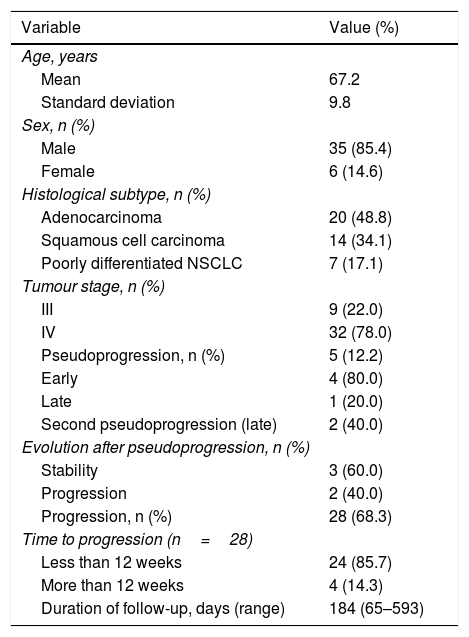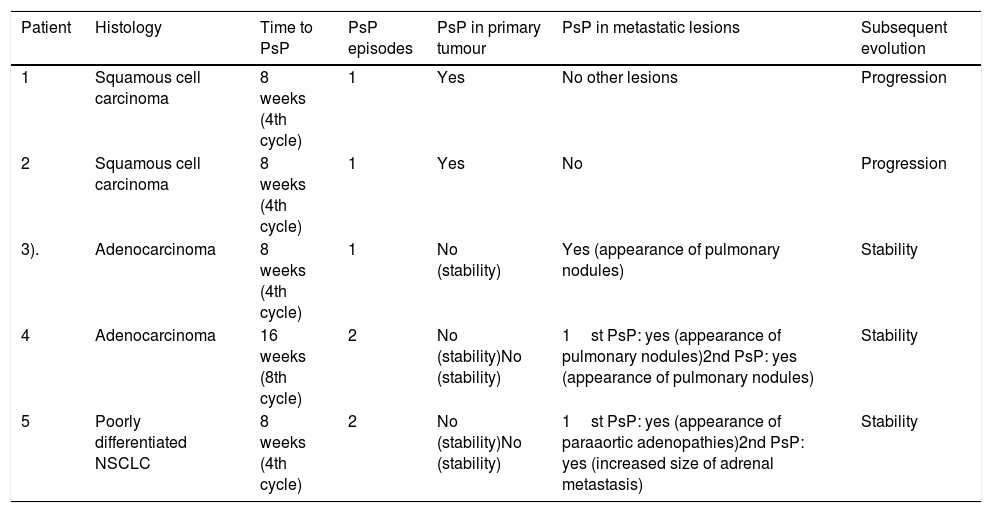Immunotherapy is a new treatment in advanced lung cancer that works by modulating the immune response against malignant cells. One aspect that is challenging for radiologists in the evaluation of the response to immunotherapy is the phenomenon of pseudoprogression, in which the infiltration of inflammatory cells causes lesions to increase in size or new lesions to appear and then decrease in size or disappear. Pseudoprogression actually represents a response to treatment. We aimed to determine the frequency of pseudoprogression in patients with advanced stages of lung cancer treated with nivolumab.
Patients and methodsWe included 56 patients with advanced stages of lung cancer treated with nivolumab as a second-line or later treatment. We analyzed CT studies done while patients were undergoing nivolumab treatment. Tumor pseudoprogression was defined as an increase in the size of lesions or appearance of new lesions followed by a decrease in size or disappearance of these lesions on follow-up CT studies 4–8 weeks later. We did a descriptive analysis.
ResultsIn 15 patients, it was impossible to evaluate possible pseudoprogression because a second CT study was unavailable due to change of treatment or death. Tumor pseudoprogression was observed in 5 (12.2%) of the 41 patients, in most cases within 12 weeks of treatment initiation (in the fourth cycle). A second episode of pseudoprogression occurred in 2 (40%) of the 5 patients with an initial episode; the second episode occurred more than 12 weeks after treatment initiation.
ConclusionTumor pseudoprogression occurred in 12.2% of patients with advanced stage lung cancer treated with nivolumab. An increase in lesion size or the appearance of new lesions must be assessed over time to avoid mistaking pseudoprogression for true progression of disease.
La inmunoterapia es un nuevo tratamiento en estadios avanzados del cáncer de pulmón de célula no pequeña (CPCNP) que modula la respuesta inmunitaria frente a células malignas. Un reto para el radiólogo es la valoración del fenómeno de la pseudoprogresión, en la que se observa un aumento o aparición de lesiones por infiltración de células inflamatorias, con posterior disminución o desaparición de estas, hecho que traduce en realidad la respuesta al tratamiento. El objetivo fue determinar la frecuencia de pseudoprogresión en pacientes con CPCNP en estadios avanzados tratados con nivolumab.
Pacientes y métodosSe incluyeron 56 pacientes con CPCNP en estado avanzado tratados con nivolumab en segunda línea o posterior. Se analizaron las tomografías computarizadas (TC) realizadas durante el período de tratamiento. Se consideró pseudoprogresión tumoral al aumento o aparición de lesiones con posterior disminución o desaparición en una TC de control realizada a las 4–8 semanas. Se realizó un análisis descriptivo.
ResultadosNo se pudo valorar la existencia de pseudoprogresión en 15 pacientes porque no se disponía de al menos dos TC (por cambio de tratamiento o fallecimiento). Se observó pseudoprogresión tumoral en un 12,2% (5/41) de los pacientes, en la mayoría de los casos antes de las 12 semanas del inicio del tratamiento (en el 4.° ciclo). Un 40% (2/5) de los pacientes con pseudoprogresión presentó un segundo episodio, que se produjo de forma tardía, a partir de las 12 semanas del inicio del tratamiento.
ConclusiónSe observó pseudoprogresión tumoral en un 12,2% de los pacientes con CPCNP tratados con nivolumab. El aumento o aparición de lesiones debe valorarse evolutivamente para evitar diagnosticar erróneamente progresión de la enfermedad.












